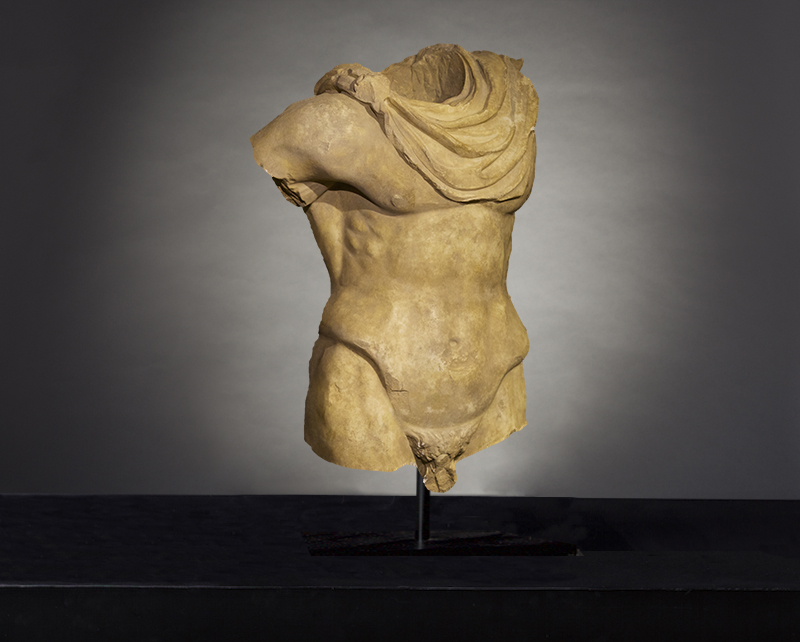GREEK AND ROMAN

The period we call “Classical Antiquity” includes three great civilizations from the Mediterranean area: Greek, Etruscan, and Roman. This era gave birth to a great and inspired civilization, in which Carthage, Rome, and Alexandria all played a part. The Greek civilization was therefore able to produce a very coherent social and cultural system, generating a philosophical and aesthetic tradition that forms a link running throughout the region. At the centre of the Greek artistic conception lies the human and heroic ideal. The poets invented this ideal and ascribed moral and physical attributes to each divinity. The Gods came out of their terrifying otherworldly existence, slowly becoming stronger and more beautiful versions of mankind, whose passions they shared. They inspired a statuary perfect both in its proportions and its grace, with the pediment of the temple of Aegina heralding the splendours of the Parthenon. When the Romans invaded Greece, they sent statues taken from the Acropolis and the Hippodromes back to Rome, and ended up submitting entirely to the influence of Greek art. Whereas the cruelty and sensuality of the Etruscan culture left the Romans only rituals and superstitions, the Greek culture was assimilated and transformed. The Roman art of portraiture was often just an imitation of the Greeks, but the Romans developed original engineering techniques for architecture, which spread through their colonies as far as the borders of the known world. It is impossible to remain indifferent to the majesty and quest for perfection found in Greco-Roman art. The peaceful harmony, realism, the devoted study of both daily life and war, and the beauty of the proportions render this period exceptional in the history of art. The Greeks sought to make themselves divine through their art, developing perfection in their techniques, and an inexhaustible proliferation, precision and subtlety.3
-
.jpg) Contact us
Contact us
DEMOSTHENES ( 382- 322 BC )
A bust of the Orator and Athenian statesman Demosthenes A fine marble copy from the 19th century patterned aftar an ancient model Height 59cm
-
 Contact us
Contact us
HYPNOS
roman2
-
 Contact us
Contact us
MARBLE ROMAN CAPITAL
roman6
-
.jpg) Contact us
Contact us
ROMAN GLASS AMPHORA (COPY)
roman8
-
.jpg) Contact us
Contact us
ROMAN MOSAIC GLASS PLATE (COPY)
roman9
-
 Contact us
Contact us
CYCLADIC SEATED HARP PLAYER
roman11
-
.jpg) Contact us
Contact us
HEAD OF GREEK CYCLADIC FEMALE (COPY)
roman12
-
 Contact us
Contact us
ATTACKS BLACK FIGURE AMPHORA
FROM 530 B.C DEPICTING ATTIKOS BLACK - FIGURE AMPHORA TYPE A. OPSIS A .ACHILEAS WITH AJAX PLAYING ON THE GROUND . OPSIS B . RETURN DIOSCURI. COPY FROME 20th century
-
 Contact us
Contact us
ATTIC HYDRIA GREEK VASE
FROM 335 - 325 D.C DEPICTING ATTIC HYDRA (KALPIDIS) CHNOSTIS REGINA VASOURONI FIG ELEUSINIAN MYSTERIES ERMITAZ COPY FROME 20th century
-
 Contact us
Contact us
GREEK AMPHORA
FROM 500-490 B.C DEPICTING PANATHINAIKOS . AMPHORA SIDE A VICTORY CROWN ATHLETE SIDE B GODDESS ATHENA. COPY FROME 20th century
-
 Contact us
Contact us
BRONZE HEAD OF APOLON
BRONZE HEAD OF APOLON
-
 Contact us
Contact us
ANTINOUS
DESC
-
 Contact us
Contact us
apollo von belvedere
DESC
-
 Contact us
Contact us
TORSO OF HERMES
DESC







